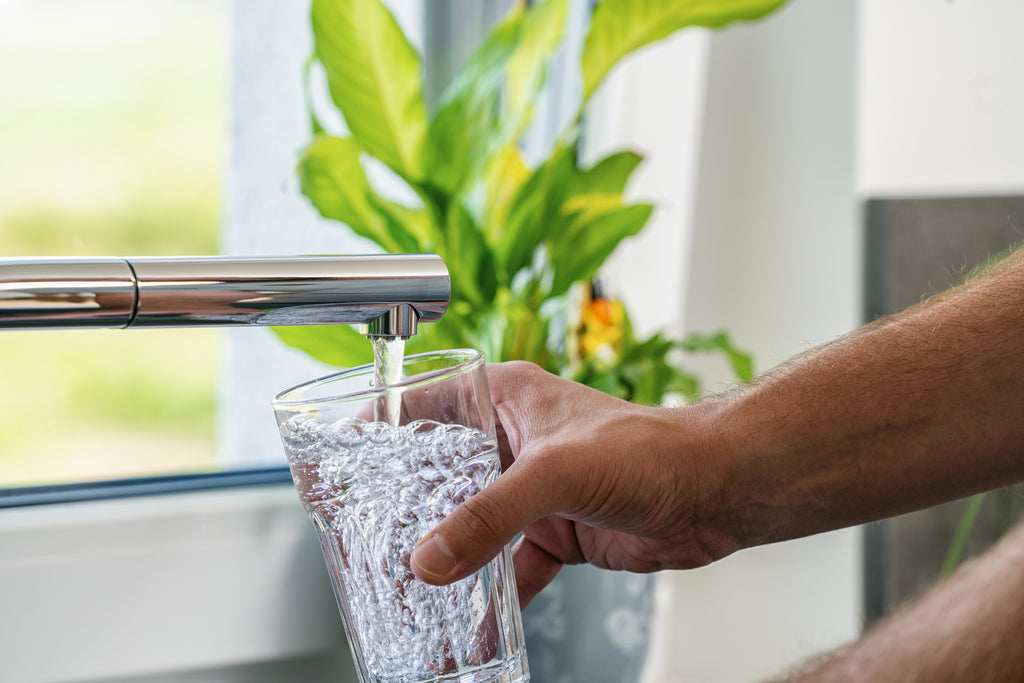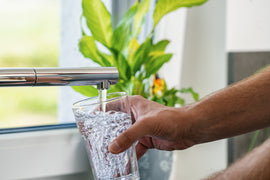Chlorinated water is typically what we think of when it comes to swimming pools. It’s not necessarily appealing in terms of drinking, which leads to the question of: is there chlorine in tap water? The answer is “yes.” Though not as much as what is used to disinfect public pools, nearly all tap water contains chlorine, since it’s the main disinfection method for city water supplies.
Knowing how much chlorine is in tap water, how chlorine-based disinfectant is used, and how chlorine in drinking water affects your health are all important areas to explore when deciding whether to drink from your tap or not. Not all cities have the same chlorine level in their water supply, nor do they all follow the same testing and treatment protocols. Can you drink sink water if it’s chlorinated? To gain a greater understanding of how and why it’s used, it’s best to start at the treatment process.1
Why Use Chlorine to Treat Water and Is It Harmful?
Public water supplies originate from different sources, some more contaminated than others. The contaminants naturally found in groundwater make their way through the pipes and trickle into communities if not treated. That’s why most municipal water systems use chlorine and chloramine as disinfectants to kill disease-causing germs, such as salmonella and E. coli, before it flows into homes for use.
Then, how much chlorine is in tap water? The Centers for Disease Control and Prevention (CDC) recommends a safe chlorine level of up to four milligrams per liter or four parts per million. These measurements are considered safe amounts of chlorine in drinking water where harmful health effects most likely won’t occur.
However, chemicals like chlorine can be harmful to younger children, immunocompromised adults, and pets, when the treated water is absorbed directly into the bloodstream. When looking at how chlorine impacts the immune system, it's important to understand that chlorine often kills off beneficial bacteria in your gut. Without the good bacteria, the immune system becomes compromised. Although these small amounts aren’t likely to be harmful, any excess of the CDC recommendations can increase the risks.
Treating the Water Supply with Disinfection Byproducts
Using chlorine in drinking water treatment for city water supplies is a process that’s been used in the U.S. since the early 1900s. There are two types of disinfectants most commonly used today: chlorination and chloramination.
Chlorination
Chlorination is the process of adding chlorine to drinking water. This is done to kill bacteria, viruses, and parasites that can cause illness for those who drink it. Used in small amounts, it’s designed to protect against waterborne diseases and still be safe for consumption.
Chloramination
Chloramination is the process of adding chloramine to drinking water as a disinfectant. Chloramine is a chemical concoction that contains both chlorine and ammonia. It is mixed at safe levels for drinking water while still potent enough to kill pollutants in the water that make people feel sick. With this process, the CDC recommends using the same levels as with chlorine to treat water. Additionally, using a purified water system for home can ensure you only drink clean water.
Often, people report disinfection with chloramine has a less distinctive “chlorine” taste and smell. However, if the water coming out of your pipes smells too much like a pool, it may mean your city’s public water system is surpassing the typical levels of chlorine disinfectant being used. To learn about exact levels of chlorine concentration in tap water, you can review your city’s annual Consumer Confidence Report. This public report is meant to inform residents of the type and amount of chemicals and pollutants found in the water source post-treatment.
If you’ve recently noticed changes to your water’s appearance, taste, or smell, you can always request at-home testing to ensure your water is safe to drink. Though your city water department monitors measurements of chlorine regularly, many prefer to drink and use filtered water exclusively both as an extra safety precaution and because it simply tastes better.
Many cities have switched to using chloramine versus chlorine. Chlorine is used up quickly in water systems, and sometimes there’s not enough chlorine disinfectant to effectively kill germs before hitting the end of the water pipes. The result is a higher risk of lingering bacteria, viruses, and germs remaining in tap water even after treatment. Furthermore, chloramine products produce fewer disinfection by-products.
Disinfection By-Products
When chlorine gas and liquid sodium hypochlorite (bleach) reacts with water during the disinfection process, it forms hypochlorous acid. Additionally, hypobromous acid is formed when there is the presence of bromine. When either acid reacts with naturally occurring organic water, disinfection by-products are formed. These include:
- Chloroform
- Bromoform
- Bromodichloromethane
- Dibromochloromethane.
Though the CDC touts there’s not enough evidence for human carcinogenicity, it’s still possible, particularly when it comes to chloroform and bromodichloromethane. However, there has been evidence these disinfection by-products have caused harm to animals, including kidney tumors and lesions on the liver. Though the threat of illness caused by disinfection by-products is less than the risk of not disinfecting water, it doesn’t make it completely safe to drink.
In essence, World Health Organization guidelines state there are certain regions where a “choice must be made between meeting either microbiological guidelines or guidelines for disinfectants or disinfectant by-products, the microbiological quality must always take precedence, and where necessary, a chemical guideline value can be adopted corresponding to a higher level of risk. Efficient disinfection must never be compromised.”3

Health Effects of Chlorine in Drinking Water
If your water smells bad, chlorine can remove the unpleasant odor. However, chlorine exposure can cause various health hazards, including irritation to the eyes, upper respiratory tract, and lungs. It can cause symptoms, such as an itchy nose or throat, dryness, and burning pain, depending on the level of chlorine in drinking water.
Other symptoms may include shortness of breath, headaches, and recurring coughing.4 Continuous exposure could heighten these effects. In addition, the taste and odor of chlorine doesn’t make drinking the chlorinated tap water enjoyable, which could lead to dehydration and subsequent adverse health effects.
Whether or not disinfectant levels are technically unharmful, there is still a risk when water is contaminated with chemicals or pollutants of any kind. It’s important to know what’s in your tap water before consuming it or inhaling its vapors in any way; otherwise, you could be susceptible to illness and disease. For this reason, many have previously chosen to drink bottled water instead.
Tap Water vs. Bottled Water: Which Has More Chlorine?
Typically, bottled water has less chlorine than tap water because manufacturers use either reverse osmosis or distillation to remove particles from the water source. Most bottled water is tap water, though, and depending on where it’s sourced from directly, could have been disinfected with chlorine.
Furthermore, bottled water poses its own health hazards due to the microplastics used. Microplastic contamination has been listed in the same category as obesogens, which are endocrine-disrupting chemicals that affect metabolism, reproduction, and oxidative stress.5 Also, the increasing strain on the environment from single-use plastic water bottles has caused many to turn to other sources for purified water options.
Plastic waste is clogging up landfills and spilling into the ocean, affecting the ecosystem, since most plastic isn’t biodegradable. As a result, the chemical by-products as plastic bottles break down, infiltrate the air, and can cause harmful exposure. Though bottled water may have less chlorine, to call it a safe drinking water option isn’t completely accurate, as there are other ways human health can be negatively affected. So, it would be better to purchase your own kitchen sink water filter.
Filtering Your Water Source with FloWater
Rather than take chances with the varying levels of contaminants — including chlorine, that can be found in tap water at any given time — the healthier option is to take advantage of the advanced water purification technology of FloWater. There are two options people have to get clean, fresh, filtered water right in their own home. To prevent drinking dirty water, people are getting themselves a purified water dispenser.
FloWater Faucet Filter
The affordable, accessible FloWater Faucet Filter transforms tap water into great-tasting, crisp, cool water. Using a five-stage micro carbon block filter, the FloWater Faucet Filter reduces lead, mercury, and arsenic to undetectable levels. It also reduces fluoride to a safe PPM concentration and eliminates the need for single-use plastic water bottles. It’s healthier than tap water and costs less than bottled water, saving an average family of four approximately $700 per year when compared to drinking bottled water at home.
FloWater Refill Station
The FloWater Refill Station is a great addition for any business. Unlike the FloWater Faucet Filter, which attaches directly to your kitchen sink’s tap, the Refill Station is a standalone water purification system that uses a multi-step system to purify and enhance the quality of the water coming from your tap. It removes up to 99% of all impurities, contaminants, and pollutants, including chlorine and chloramine, while also adding back healthy minerals and electrolytes for a better drinking experience. A coconut carbon filter finish ensures all lingering odors and tastes are removed, leaving behind the purest water possible.
Hydration is such a crucial part of maintaining good health that not having access to clean water can be detrimental. Now, with options of filtering tap water right at the source, it’s easier to stay hydrated and healthy at home. It eliminates the need for plastic water bottles, and allows the family to refill their reusable bottles and jugs for at-home use to take with them on the go. No more strong odors and tastes, but rather refreshing water that tastes great.
Sources:
- “Water Disinfection.” The Centers for Disease Control and Prevention.
- https://www.cdc.gov/healthywater/drinking/public/water_disinfection.html#.
- “Disinfection By-Products.” The Centers for Disease Control and Prevention.
- https://www.cdc.gov/safewater/chlorination-byproducts.html.
- “16. Disinfectants and disinfectant by-products.” The World Health Organization.
- https://www.who.int/water_sanitation_health/dwq/2edvol2p2e.pdf
- “Chlorine.” U.S. Environmental Protection Agency.
- https://www.epa.gov/sites/production/files/2016-09/documents/chlorine.pdf.
- “Which is better: Bottled water or tap water?” Medical News Today.
- https://www.medicalnewstoday.com/articles/327395#pros-and-cons-of-bottled-water.





